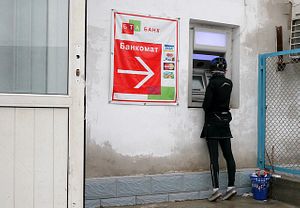Rumors of a merger between Kazakhstan’s two largest lenders, Halyk Bank and Qazkom, have stirred a debate in the country, as the new superbank would control around 40 percent of the sector.
Sources close to the two banks told Reuters that the two banks were negotiating. Initially, Qazkom denied it: “Responding to recent rumors, I can say that Qazkom has neither made nor received offers regarding a merger with Halyk Bank,” Qazkom’s press officer, Sergei Chikin, told media.
Last week, however, Halyk Bank’s chairwoman, Umut Shayakhmetova, opened the door for a possible partnership.
“Despite pessimism, many of the negative predictions on the country’s banking sector were not confirmed this year. When projecting possible scenarios, we studied the possibility of some kind of alliance with Qazkom, I wouldn’t specifically talk about a merger,” Shayakhmetova told local press.
This rather vague statement, however, falls short from denying a possible merger in the coming months.
The two sources quoted by Reuters said that a merger would only happen once Halyk redeems a $638 million Eurobond next May. Floating the rumor could be a good strategy to prepare observers and boost the banks’ profiles.
Both banks are strongly tied to the Kazakh elite and one of the sources said that the idea behind the merger came from the very top, from President Nursultan Nazarbayev himself.
Nazarbayev’s daughter Dinara and her husband, Timur Kulibayev, control Halyk Bank. Kenes Rakishev, who owns a majority stake in Qazkom, is the son-in-law of Imangali Tasmagambetov, deputy prime minister and a long-term ally of the president.
Kazakhstan’s banking sector could soon undergo a makeover.
In mid-2014, when Kazakhstan was just recovering from the virus of non-performing loans it caught after the global financial crisis of 2007-2008, the Central Bank planned a restructuring of the banking sector, which would have been achieved through a steady increase of minimum capital requirements. In five years, it would have grown by tenfold, from 10 billion to 100 billion tenge (from $54 million to $543 million at the time) and it would have shrunk the number of banks from 35 to a dozen.
After the Central Bank decided to abandon the peg to the U.S. dollar in August 2015, allowing the tenge to fall sharply and avoiding any interference in the currency market, the plan to increase capital requirements was halted. But this didn’t stop the restructuring of the sector.
Gradually increasing his stake, in less than two years Kenes Rakishev became Qazkom’s majority shareholder with a direct and indirect ownership of 71.3 percent of the bank. Nurzhan Subkhanberdin, its once-powerful owner, was cornered and relinquished the majority of his stake. In October this year, the bank rebranded from Kazkommertsbank, officially to celebrate its 25th birthday, and perhaps also to mark the complete change of ownership.
In 2014, Qazkom absorbed the toxic assets previously owned by BTA Bank, once the largest bank in Kazakhstan under the leadership of Mukhtar Ablyazov. The banker-turned-politician fell from grace and fled the country, accused of having embezzled billions from his bank. BTA was then bailed out by the sovereign wealth fund Samruk-Kazyna and its value dropped significantly. In 2014, Qazkom and Rakishev, who didn’t own banking shares then, bought BTA, its overdue loans, and its debts. Despite a massive write-off, BTA’s toxic assets linger on in Qazkom’s books today.
The progressive drop in the percentage of non-performing loans in Kazakhstan’s banking sector could have been the spark that prompted the possible merger between Qazkom and Halyk. Both are now owned by people with close ties to the elite and, together, they could solve once and for all the long-standing problems in their balance sheets.
A superbank in Kazakhstan would dwarf its competitors. Together, Qazkom and Halyk would control almost 40 percent of the banking sector in the country and be almost five times larger than their closest competitor, Tsesnabank. For a proportionate comparison, it would be quite similar to a scenario where Russia’s top-two banks Sberbank and VTB merged, capturing around 42 percent of the market. In a Russian scale, however, the Qazkom-Halyk partnership would rank 10th among the largest banks.
It remains to be seen whether the plan goes forward in 2017. Given the recent movements in Kazakhstan’s banking sector, such a scenario would hardly come as a surprise.

































